
|
Hunters Information Service is always on the lookout for outstanding workmanship which might
be of interest to the world hunting community. It stands to reason, we figured, anyone involved
in the type of work Mark Minton is, there at Trophy Care International, must have at least one or
two jobs they considered to be their most unusual or challenging projects. We asked Mark to
tell us about his most outstanding projects to date. Here are the results of that
inquiry! One of the most frequent questions we are asked is, "What is the most interesting thing you ever worked on?" I used to answer that the most thrilling to me was doing restoration work on a Black Rhino head taken by Teddy Roosevelt back in 1909. It seemed impossible, but I was actually touching something Teddy Roosevelt had touched! That Rhino was a thrill but if asked the same question today, the answer is instantaneous. Restoring a full set of Ice Age Megaloceros antlers, complete with the actual skull, for the International Wildlife Museum at Safari Club International headquarters in Tucson, AZ! The Megaloceros, commonly called the Giant Deer or Irish Elk, is supposed to have looked much like our own Rocky Mountain Elk of today, however, it had a few, shall we say, "differences?" It had heavily muscled shoulders and very thick, heavy neck bones. That 'difference' was needed to support a set of antlers that measured up to 12. feet from tip to tip! They shed those antlers each winter and grew a full new set each summer! According to Archeologists, this magnificent animal was found throughout Northern Europe and Asia. Mostly extinct by the end of the Ice age, between 10,000 to 30,000 years ago, a few reportedly survived in Central Europe until about 500 BC.
The different stages of repair, from start to finish, are shown in these three photos.
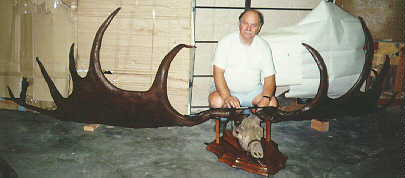 Mark Minton with finished antlers showing how large these antlers turned out to be.
Waiting their turn at final touch-up, while Mark works on an Emperor Penguin, are two other Penguins from one of Admiral Richard Byrd's early 1920's Antactic expeditions.Initially, I figured the job would take around 3 to 4 days. That was before I convinced the Museum Director and Curator that such an awesome set of real antlers (as opposed to fossilized) truly deserved to be restored completely. Complete restoration meant all broken off and missing tines had to be built out to their original, incredible, lengths - using opposing tines as a yardstick. Any and all cracks and holes had to be filled in. Any missing parts of the antlers had to be sculpted back in place, and all the vein-lines and natural grooves needed to be restored and matched up to where there were no breaks in continuity. Finally, I had the privilege of painting the whole thing back to its original colors, at least as near as imaginable, only slightly darker to indicate the fact it had been buried for many thousands of years when first discovered. The original plan had called for me to restore them just enough to cover any major flaws, and hide the myriad of minor ones by simply painting them over with the same type of thick, heavy , black house paint which had covered them when they arrived, in pieces, at the museum. The way they must have looked when they had originally been "restored." Under the new plan, instead of 3 to 4 days to complete job, it took two full weeks, sometimes working late, to complete the job! Both main beams had been broken in two and twisted out of place when I first started, which had made accurate measurement impossible. To our utter amazement, with everything finally restored and in proper alignment, the antlers now measured an astounding 13 feet from tip to tip! Longer than any I had ever heard of when researching the animal! What a challenge and what a thrill!
Phone/Fax: 360-653-7300 or Cell Phone: 206-353-8813
or contact us through our

|
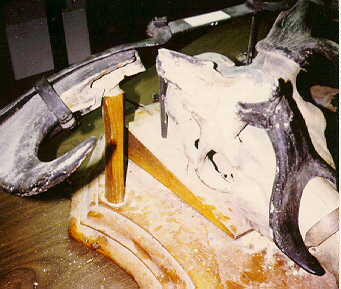
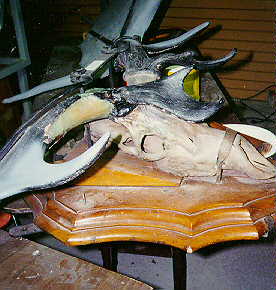
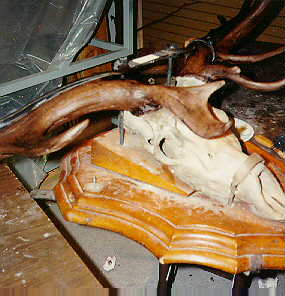 This astounding set of antlers, literally in pieces and gathering even more dust, lay around for years in a back room at
the International Wildlife Museum, in Tucson, AZ. I had seen the antlers when TCI cleaned all the museums mounts for the first time in 1994, and I was absolutely fascinated by them. With both main beams broken and in pieces, as they were, it was impossible to tell just how wide they actually were. Rough measurement showed they had to be close to 12' from tip to tip. Almost as large as any previously documented!
This astounding set of antlers, literally in pieces and gathering even more dust, lay around for years in a back room at
the International Wildlife Museum, in Tucson, AZ. I had seen the antlers when TCI cleaned all the museums mounts for the first time in 1994, and I was absolutely fascinated by them. With both main beams broken and in pieces, as they were, it was impossible to tell just how wide they actually were. Rough measurement showed they had to be close to 12' from tip to tip. Almost as large as any previously documented!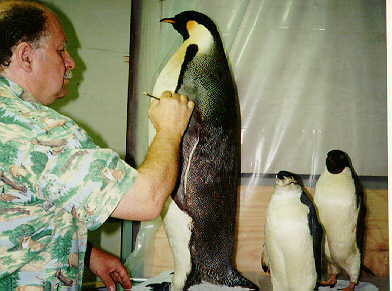 While I was there I saw again that busted up rack of Giant Deer antlers and knew I just had to be the one to do the
restoration work! So, when I had completed what I called "Project Penguin," I made the Museum Staff and Director an
offer which, fortunately, they found hard to refuse: If they would pay the expenses to extend my stay, I would donate
whatever time it took to restore the antlers and skull for them. In their present state, at that time, they could not possibly
be put out on display!
While I was there I saw again that busted up rack of Giant Deer antlers and knew I just had to be the one to do the
restoration work! So, when I had completed what I called "Project Penguin," I made the Museum Staff and Director an
offer which, fortunately, they found hard to refuse: If they would pay the expenses to extend my stay, I would donate
whatever time it took to restore the antlers and skull for them. In their present state, at that time, they could not possibly
be put out on display!